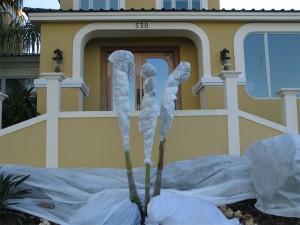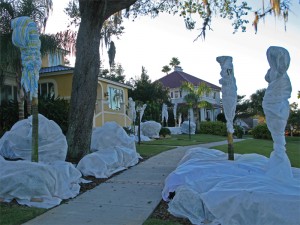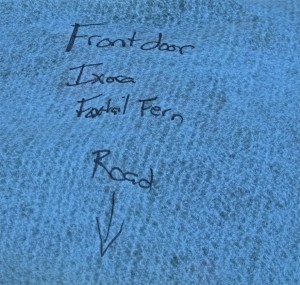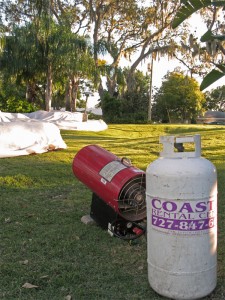Give your cold-sensitive palms the “Blanket Treatment”.
If you’ve planted new or cold sensitive palms in your garden, you will need to take some protective measures once the thermometer hovers just above freezing or goes below freezing. The first two years in a palm’s life in the ground are especially critical. Think about your palm tree as a new baby, and like babies, palms need cold weather protection.
Here are some Garden Fairy factoids for Floridians and tips for protecting your palms.
Why are palms vulnerable to cold?
The interior of a palm tree holds bundles of water-conducting tubes. The tubes in the outer layers of the tree will suffer frost damage when exposed to cold. In mature palms, outer layer damage actually works to insulate the palm tree’s core during future freezes. But when a palm is very young, the trunk is not large enough to sacrifice any of it’s core to frost protection. Newly planted palms can freeze right through in a single cold night.
Is there a difference in degrees of cold?
Light frosts- existing fronds experience browning around the edges, and some may die out entirely.
Moderate frost- the palm could lose all the green foliage at the top of the tree, but it will grow back from healthy tissue in the heart.
Severe frost- the tissue in the heart of the palm, located deep on the very center of the foliage head freezes and dies, killing the tree.
Which palms are cold sensitive?
It depends on where you live. First, establish what zone you are in and find out what palms are cold hardy for your zone. The hardest palms for the Tampa Bay area include; Bismarck, Chinese Fan, Cardboard, Coontie, Paurotis, European Fan, Lady, Needle, Pindo, Pygmy Date, Queen, Ribbon Fan, Sabal Minor, Sago, Saw Palmetto, Sylvester, Washingtonia and Windmill.
If you live in South Florida which squarely is in the tropical zone 10 you can successfully grow many more palms than we can in Tampa Bay. The northern part of Tampa Bay is a much more challenging place to grow tropical palms being in sub-tropical zone 9.
Many people want to know where the zone 10 starts in Central Florida. This is a debatable subject, but somewhere above St. Pete is the starting line for zone 10. If you travel the length of Pinellas County you will see many more tropical palms and plants surviving in the southern part of the county compared to the northern areas.
Beware when picking out palms. Just because Home Depot, Lowes and Wal-Mart are stocking lots of tropical palms doesn’t mean they are suitable for your area. Cold sensitive palms include; Royal, Spindle, Christmas, Bottle, Solitaire, Coconut, Bismarck and Cuban Date Palms.
These palm trees need lots of extra care in order to survive our Tampa Bay frigid blasts of cold.
See more info Readily available palms NOT NECESSARILY RECOMMENDED for Central Florida
Garden Fairy tips for protecting your young and cold-tender palms:
1. Cover em up!
• Any type of fabric cover will do, but avoid heavy quilts when covering palm fronds which might result in a misshaped palm head or “palm bed-head”. The Garden Fairies use a combo of different types of blanketing solutions; sheets, blankets, pillow cases, old clothes and painters drop cloths.
• Freeze cloths- If you have lots of area to cover you might want to invest in freeze cloths. Garden retailers sell freeze cloth in large sheets, by the yard. Freeze cloths are reusable, they dry out quickly and allow sunlight to reach the plants. Unlike old bed sheets, freeze cloth does not have to be laundered.
2. Avoid plastic- Cold moves right through plastic, so wherever it’s resting on the foliage it transfers through to freeze the leaf. Additionally, plastic doesn’t breath and may develop condensation overnight, which can freeze in the coldest hours of early morning.
3. If it’s going to be really cold:
• Place a bucket or jug of water in your house during the day to collect heat. Water releases heat slower than soil and air, so if you have the jug under your cover it will maintain a little heat throughout the night so your plants won’t freeze.
• Add xmas lights under your freeze cloth. Make sure the lights don’t touch the cloth. Nobody wants to start anti-freeze fire!
• Wrap the palm with fabric, leaving some extra room. Pour a layer of mulch or manure (brings the temp up even more) in between the cloth and the tree.
• Freeze-Pruf- a new product, that has not been tested by the Garden Fairies. It is a spray mist that claims to help a plant endure temperatures 2.2 to 9.4 degrees Fahrenheit colder than it would without the spray, depending upon the species. It is available online.
4. Water BEFORE a freeze. A thirsty palm will suffer more during cold spells.
5. Mulch- Mulch is an effective counter measure. It helps the soil retain some warmth for a short period. Use a good layer of mulch about 3 to 6″ thick. Don’t underestimate the power of this easy tip! Most fine and tender feeder roots are close to the surface and thus the palm’s root system is the most cold-tender part and will suffer most damage in a freeze.
5. Extreme Measures- as seen in one of the featured photos. This propane heater is being used in the yard of a wealthy Tarpon Springs resident to keep the homeowner’s palm trees warm. I am a rabid plant lover myself, but I think this is pretty extreme when you think of all the homeless people out there this week.
• Kerosene Heater- a method pioneered by citrus growers. The problem with this method is it’s dangerous and you might set your plants— or even yourself on fire if you are not careful (YIKES). Plus you need to stay up during a freezing night and observe your heaters. This definitely is effective but limited to your own taste of adrenalin and sleep deprivation.
Stay warm! More tips on protecting your plants




Where can I purchase freeze cloths in bulk online?
You can find buy freeze cloth for $0.55/ FT at FarmTek http://www.farmtek.com/farm/supplies/ProductDisplay?catalogId=10052&division=FarmTek&isDoc=N&pageId=ItemDetail&productId=68777&storeId=10001
Additional sources are at The Find http://www.thefind.com/garden/info-frost-protection
Is it safe to leave palm wrapped in freeze cloth for the whole winter??